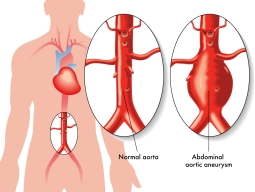Are You At Risk for An Aneurysm?
From an interview with
Dr. Luke Stewart
McLeod Vascular Associates – Florence
An aneurysm is a bulging or ballooning of an artery that is greater than 50 percent of the normal width of the artery. The most common aneurysm, the abdominal aortic aneurysm, is in the aorta, located below the kidney arteries. The aorta is the main blood vessel in the body. It carries blood from the heart, all the way to the organs in the stomach, down to the legs.
If an abdominal aortic aneurysm were to rupture, it could potentially cause significant bleeding, possibly even leading to death. To prevent rupture, aneurysms are repaired when they reach a certain size. For a female, it is five centimeters and for a male, it’s 5.5 centimeters. Data has shown females have a higher risk of rupture at a slightly smaller diameter, and males at a slightly bigger diameter.
Currently, aneurysms cannot be prevented. What causes them to form isn’t exactly known. Atherosclerosis, hardening of the arteries, is thought to play an important role. The biggest risk factors for aneurysms are smoking and family history. About 75 percent of abdominal aortic aneurysms occur in patients with a history of smoking, according to the U.S. Centers for Disease Control and Prevention. With family history, you are at a higher risk if a first line relative had an aneurysm (mother, father, brother, sister).
One of the more common ways to find an aneurysm is during a non-related MRI or CT scan. When this occurs, the patient is then referred to a vascular surgeon for further evaluation and treatment. The first step in treatment is to check the size of the aneurysm. If it is below threshold size for repair, a monitoring program is established for the patient to see one of our vascular surgeons at regularly scheduled intervals. If the aneurysm meets the size for repair, then there is a discussion regarding the repair options.
If you are concerned about an abdominal aortic aneurysm, speak with your primary care physician about a referral to McLeod Vascular Associates.
-
McLEOD REGIONAL MEDICAL CENTER FLORENCE
843-777-2000 -
McLEOD DARLINGTON
843-777-1100 -
McLEOD DILLON
843-774-4111 -
McLEOD LORIS
843-716-7000 -
McLEOD SEACOAST
843-390-8100 -
McLEOD CHERAW
843-537-7881 -
McLEOD CLARENDON
803-433-3000



-
McLEOD REGIONAL MEDICAL CENTER FLORENCE
843-777-2000 -
McLEOD DARLINGTON
843-777-1100 -
McLEOD DILLON
843-774-4111 -
McLEOD LORIS
843-716-7000 -
McLEOD SEACOAST
843-390-8100 -
McLEOD CHERAW
843-537-7881 -
McLEOD CLARENDON
803-433-3000
 Find a Doctor
Find a Doctor  Locations
Locations  Services
Services 